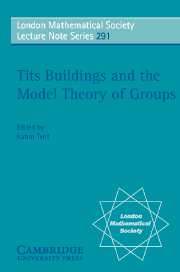Book contents
- Frontmatter
- Contents
- Preface
- List of speakers and talks
- Basics on buildings
- An introduction to generalized polygons
- Buildings and classical groups
- Twin buildings
- Twin trees and twin buildings
- Simple groups of finite Morley rank of even type
- BN-pairs and groups of finite Morley rank
- CM-trivial stable groups
- Amalgames de Hrushovski: Une tentative de classification
- Rank and homogeneous structures
- Constructions of semilinear towers of Steiner systems
- Introduction to the Lascar Group
Constructions of semilinear towers of Steiner systems
Published online by Cambridge University Press: 12 January 2010
- Frontmatter
- Contents
- Preface
- List of speakers and talks
- Basics on buildings
- An introduction to generalized polygons
- Buildings and classical groups
- Twin buildings
- Twin trees and twin buildings
- Simple groups of finite Morley rank of even type
- BN-pairs and groups of finite Morley rank
- CM-trivial stable groups
- Amalgames de Hrushovski: Une tentative de classification
- Rank and homogeneous structures
- Constructions of semilinear towers of Steiner systems
- Introduction to the Lascar Group
Summary
Introduction
In this paper, model-theoretic methods based on Fraïssé amalgamation are used to build structures whose automorphism groups are infinite Jordan permutation groups. The structures themselves are Steiner systems, or ‘towers’ of Steiner systems in the sense of or. These are defined in Section 2.
Throughout the paper, (G, Ω) will denote a permutation group G on a set Ω. Recall that if (G, Ω) is transitive and Γ ⊂ Ω, then Γ is a Jordan set if |Γ| > 1 and the pointwise stabiliser in G of Ω\ Γ is transitive on Γ. The Jordan set is improper if for some n ∈ N, G is (n + 1)-transitive on Ω and |Ω\Γ| = n, and is proper otherwise. A Jordan group is a transitive permutation group with a proper Jordan set.
By a result of Jordan (see Theorem J1) any finite primitive Jordan group is 2-transitive, and using the classification of finite simple groups the finite primitive Jordan groups have been classified - see for example or Kantor. A structure theorem for infinite primitive Jordan groups is given in, based on earlier work in. If such a group is not highly transitive (that is, k -transitive for all positive integers k), then it must be a group of automorphisms of some relational structure on Ω which is non-trivial in the sense that not every permutation is an automorphism.
- Type
- Chapter
- Information
- Tits Buildings and the Model Theory of Groups , pp. 235 - 278Publisher: Cambridge University PressPrint publication year: 2002
- 2
- Cited by



